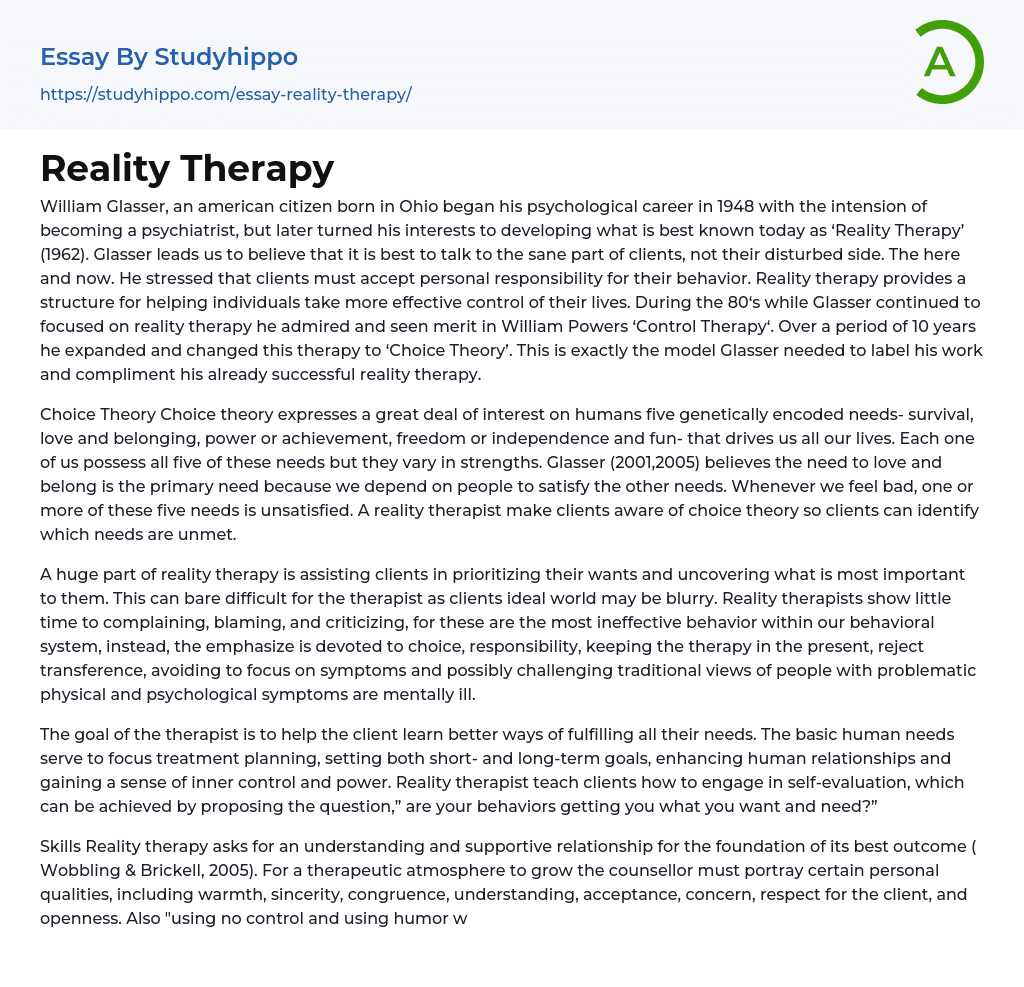William Glasser, born in Ohio, initially worked as a psychiatrist starting in 1948. However, he later shifted his focus to the development of 'Reality Therapy' in 1962. According to Glasser, it is crucial to engage with clients' rational side rather than their disturbed state and focus on the present moment. He emphasized the importance of clients taking personal responsibility for their actions. Reality therapy provides a framework for empowering individuals to take control of their lives. Throughout the 80s, Glasser remained dedicated to reality therapy but also recognized the value of William Powers' 'Control Therapy'. Over time, he adapted and expanded this therapy into 'Choice Theory', which not only provided an appropriate label for his work but also enhanced his already successful reality therapy.
Choice theory focuses on five ge
...netically encoded needs in humans: survival, love and belonging, power or achievement, freedom or independence, and fun. These needs drive us throughout our lives. We all possess these five needs, but their strengths vary from person to person. Glasser (2001,2005) argues that the need to love and belong is the primary need because we rely on others to fulfill the other needs. When we feel bad, it is usually because one or more of these needs are not being met. Reality therapists aim to make clients aware of choice theory so that they can identify their unmet needs.
Reality therapy involves helping clients prioritize their desires and discover their deepest values. This can be challenging for therapists because clients may have a vague concept of their ideal life. Rather than allowing clients to engage in unproductive behaviors like complaining, blaming, and criticizing
reality therapists prioritize choice, responsibility, focusing on the present, avoiding transference, and challenging traditional notions about those with physical and psychological problems being mentally ill.
The therapist's goal is to help the client develop better ways of meeting their needs. Treatment planning and goal setting revolve around basic human needs, with the aim of improving relationships and fostering a sense of control and empowerment. Reality therapists educate clients on self-assessment by asking them if their behaviors are fulfilling their desires and requirements.
Reality therapy in counseling requires an understanding and supportive relationship as the foundation for its best outcome (Wobbling ; Brickell, 2005). To foster a therapeutic atmosphere, the counselor must exhibit certain personal qualities, such as warmth, sincerity, congruence, understanding, acceptance, concern, respect for the client, and openness. Additionally, employing no control and incorporating humor can help establish a relationship and create a positive impact, leading the client to regard the counselor in their quality world and seek their guidance. The effectiveness of therapy begins with the therapist's acceptance into the client's quality world.
The Myrtle Beach Conference on Reality Therapy in 2008 emphasized the significance of the therapist-client relationship. This relationship is crucial for clients to develop a greater awareness of the repercussions of their behaviors. Therapists typically initiate this process by inquiring about the client's therapy objectives and exploring any dissatisfying connections with their spouse, child, parent, friend, or employer. Furthermore, therapists commonly ask a question that subtly implies control: "Whose behavior can you control?"
According to Dr. William Wubbolding (2007), it is crucial to encourage clients to concentrate on what they can control in order for therapy
to be successful. By acknowledging their power over their own actions, therapy becomes more effective. The objective is to assist clients in making improved choices and enhancing their overall well-being, particularly if they are resistant to altering their current behavior.
According to Glasser (1998), reality therapy and choice theory can be utilized in both individual and group settings for individuals with any psychological issue, irrespective of their cultural background. Glasser highlights that relationships are the central concern in all cultures since we are all part of the same species and share a common genetic structure. However, Wubbolding (2007) stresses the importance of applying choice theory principles creatively, with cultural sensitivity, and especially with flexibility when implementing reality therapy procedures.
Reality therapy workshops have been conducted by Wubbolding in various countries including Japan, Taiwan, Hong Kong, Singapore, Korea, India, Australia, Slovenia, and countries in Europe. Based on his experience, it is challenging to make generalizations about other cultures. For instance, the Japanese language lacks a direct translation for the words "plan" and "accountability," which are both important aspects of reality therapy. In Western counseling settings, clients are not satisfied with responses like "I'll try" when asked to create plans and commit to them. They insist on a clear pledge to follow through. However, in Japanese culture, counselors are more likely to perceive "I'll try" as a firm commitment.
The core of reality therapy involves acquiring improved decision-making skills and achieving greater control. It encourages individuals to take control of their lives instead of being helpless victims of uncontrollable circumstances.
- Anatomy and Physiology essays
- Addiction essays
- Biodegradation essays
- Dental Care essays
- Disease essays
- Disorders essays
- Health Care essays
- Intelligence Quotient essays
- Nutrition essays
- Olfaction essays
- Public Health essays
- Women's Health essays
- World health organization essays
- Cancer essays
- Infectious Disease essays
- Lung Cancer essays
- Neurology essays
- Physical Exercise essays
- Medicine essays
- Sex essays
- Inquiry essays
- Disability essays
- Poison essays
- Action Potential essays
- Nervous System essays
- Childbirth essays
- Puberty essays
- Blood essays
- Kidney essays
- Neuron essays
- Body essays
- Glucose essays
- Sense essays
- Heart essays
- Skeleton essays
- Human Physiology essays
- Eye essays
- Immune System essays
- Muscle essays
- Skin essays
- Brain essays
- Central Nervous System essays
- Human Skin Color essays
- Digestive System essays
- Common sense essays
- Respiration essays
- alcoholism essays
- Smoking essays
- Casino essays
- Tobacco essays




